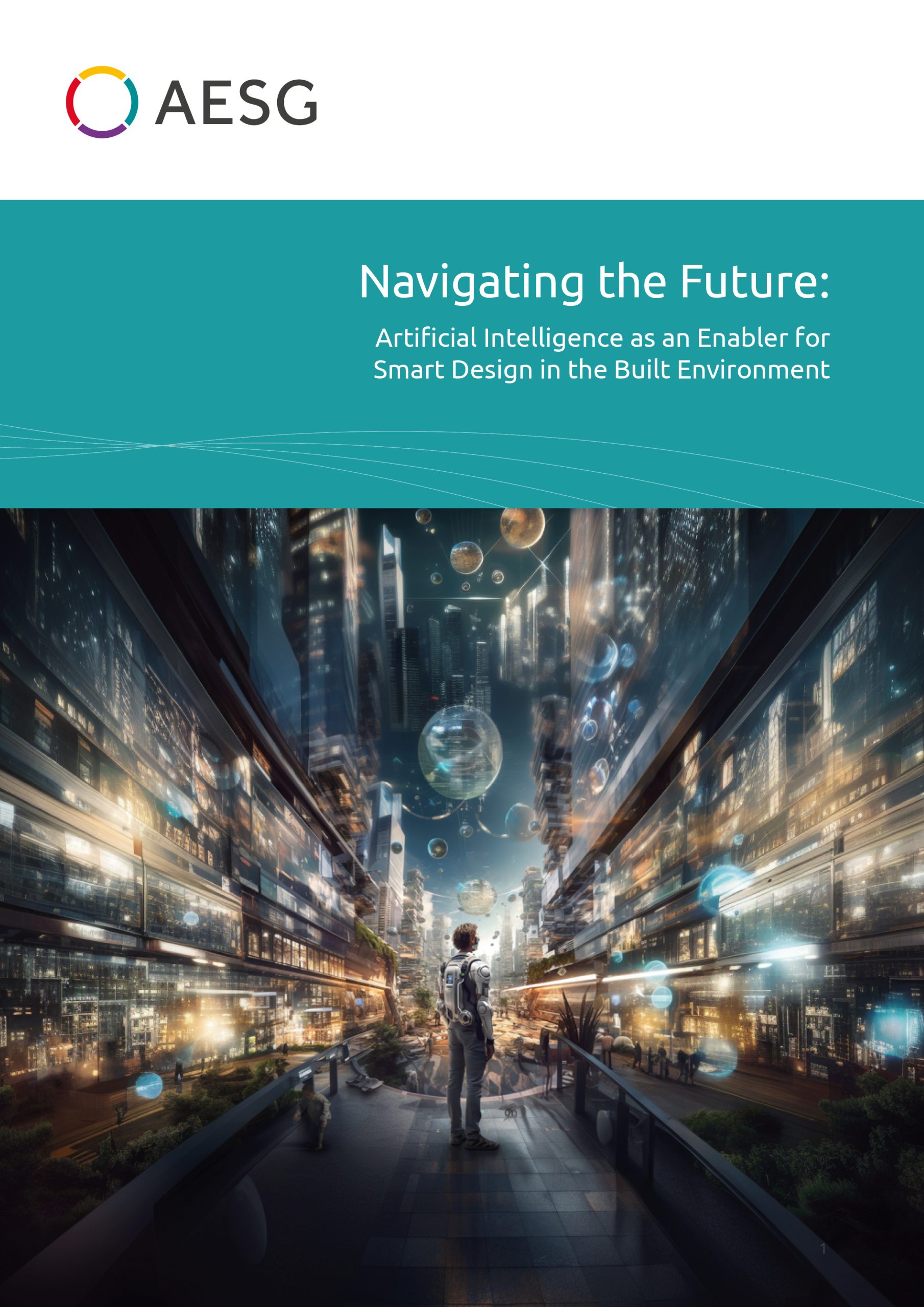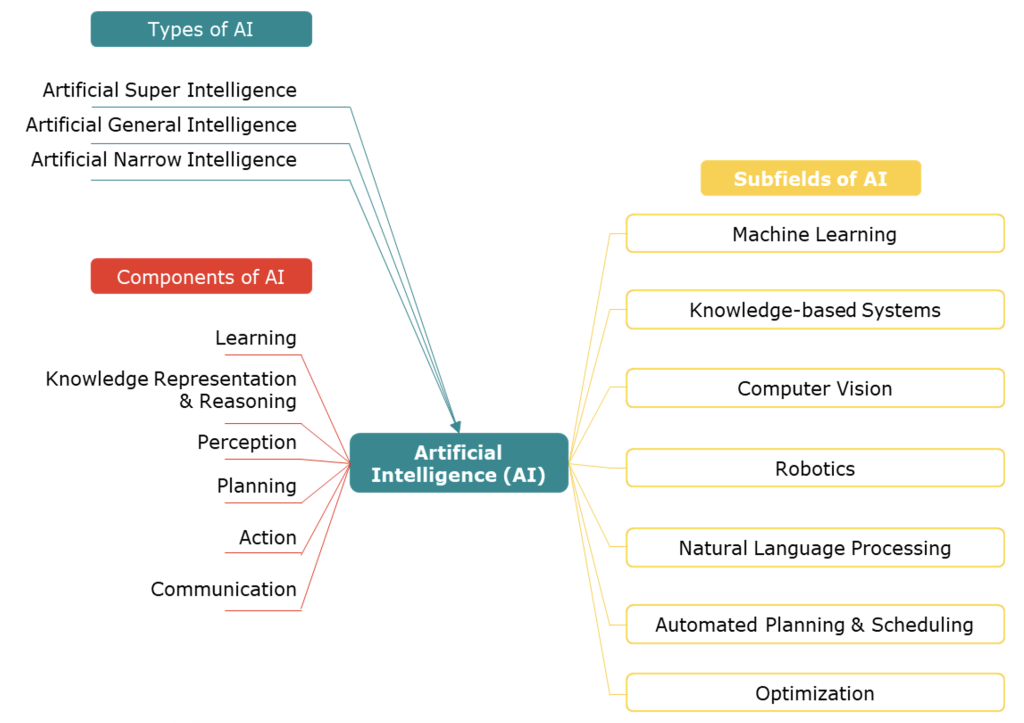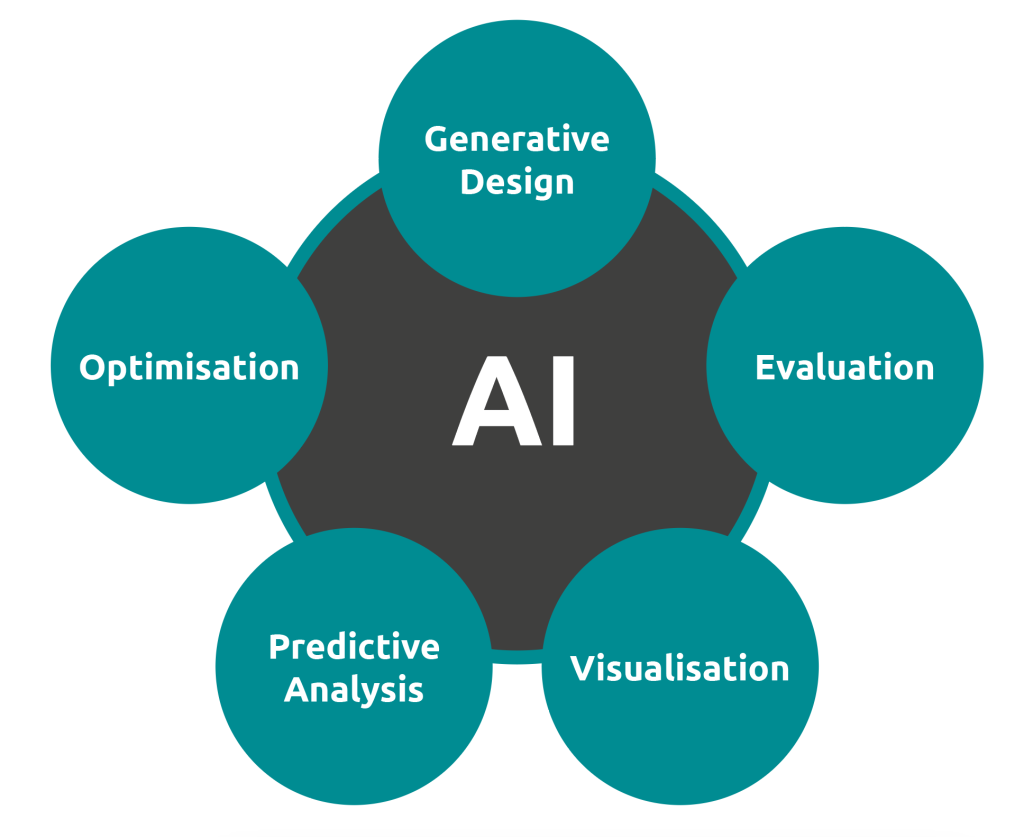
In less than a century, the tools of design and creativity have evolved from pencil and paper to computers, software, IoT, and now Artificial Intelligence (AI).
Over the last few decades, AI has shifted from a sci-fi concept to an integral part of our everyday reality. This introduction lays the foundation for delving into AI’s profound impact, as it not only mirrors human thinking but also reshapes urban landscapes.
Amid this era of unparalleled innovation, AI leads us towards intelligent, eco-conscious urban spaces, signifying progress and propelling efficient design. With AI as an enabler, the creative process gains fresh ingenuity, enriching the path to effective design.
1. Abstract
This paper delves into AI’s profound impact on the built environment, focusing on its role as a catalyst for smart design and sustainability. By elucidating AI’s ability to simulate human intelligence, the paper underscores its significance in generating innovative design options. Moreover, AI’s integration into the built environment enables real-time monitoring of energy usage, timely detection of anomalies, and data-driven design.
As AI unfolds its potential, it opens doors to a future marked by generative design evolution, adaptive and predictive solutions, human-centric spaces, and regenerative design. Amidst these trends, ethical considerations and mixed reality integration emerge as crucial facets, ensuring a harmonious synergy between technological progress and the betterment of human lives and the environment.
Ultimately, this paper envisions a trajectory toward intelligent, sustainable design empowered by AI, steering the built environment industry toward a future where innovation and ethics converge.
2. Artificial Intelligence
Artificial Intelligence refers to the simulation of human intelligence processes by machines, particularly computer systems. These processes include learning, reasoning, problem-solving, and decision-making. Essentially, AI enables machines to perform tasks that typically require human intelligence.
Now, let’s explore how AI relates to the built environment. In recent years, AI has emerged as a transformative tool within the context of designing and managing the built environment, which encompasses everything from buildings and infrastructure to urban planning. AI’s ability to process and analyse vast amounts of data quickly has revolutionised how we approach these areas.
In essence, AI’s integration into the built environment and sustainability efforts empower us to create smarter, more efficient, and environmentally conscious structures and cities. It offers the potential to enhance our quality of life while minimising our ecological footprint, fostering a harmonious coexistence between human needs and the planet’s well-being.
3. Types of AI
Artificial Intelligence (AI) is broadly categorised into three primary types:
Narrow AI (or Weak AI)
This is the only form of AI we have fully realised. Narrow AI systems are designed and trained for a particular task. Examples include the voice assistants Siri and Alexa, ChatGPT, Grammarly, and Midjourney.
Narrow intelligence can be used to optimise traffic flow, manage energy consumption, and improve public safety. One prime example is the smart thermostat systems like “Nest”. These devices learn from residents’ preferences and daily routines, adjusting the temperature for optimal comfort while maximising energy efficiency.
General AI (or Strong AI)
This form of AI could theoretically perform any intellectual task that a human can. As of now, we do not yet have AGI (Artificial General Intelligence).
While AGI does not currently exist, its potential application in the built environment is vast. Imagine a building management system with the cognitive abilities of a human facility manager. This system could oversee every aspect of a building’s operations, from energy management to tenant relations, making decisions based on a vast array of data points. For instance, it could adaptively reconfigure office spaces based on the evolving needs and preferences of its inhabitants, all while considering factors like energy consumption, building materials’ lifecycle, and more.
Superintelligent AI
This is a theoretical form of AI that would surpass the best human minds in practically every field, including scientific creativity, general wisdom, and social skills.
In the context of the built environment, a superintelligent AI could revolutionise the way we conceive, design, and manage spaces. Going beyond mere building management, such an AI could design entire urban landscapes optimising for factors we haven’t even considered. For instance, it could create a city layout that maximises green spaces, pedestrian mobility, and solar energy generation while minimising resource waste, pollution, and congestion. It could foresee and solve urban challenges long before they manifest, leading to highly resilient, sustainable, and harmonious urban ecosystems.

Figure 1. Artificial Intelligence types, components, subfields, Abioye et al. (2021)
4. AI and the Built Environment
Artificial intelligence is rapidly changing the world, and the built environment industry is no exception. AI is being used to automate tasks, generate designs, and make decisions, all of which can help us to be more efficient and productive in our work.
The rise of AI is set to revolutionise the way we design. AI can be used to generate a vast array of design possibilities, and it can help us make better decisions about our designs. AI can also be used to automate many of the tasks involved in the design process, freeing us up to focus on more creative and strategic work. This can be summarised in the below main points:
Mixed Reality Integration
The fusion of AI with mixed reality tools like augmented and virtual reality can further revolutionise design and urban planning. Designers could visualise AI-generated solutions in real time and in context, making for a more intuitive and collaborative design process.
Human-Centric Spaces
A crucial aspect of AI’s role in the built environment is its potential to create human-centric spaces. By understanding and analysing human behaviour, AI-driven designs can optimise spaces for comfort, productivity, and well-being. This includes aspects like maximising natural light, ensuring efficient airflow, or creating communal spaces that foster interaction.
Regenerative Design
Beyond sustainability, the future of design lies in regeneration. This means creating spaces and structures that don’t just minimise harm but actively contribute to the betterment of the environment. AI can facilitate this by analysing and implementing design strategies that regenerate natural systems, for instance, by purifying air, recharging groundwater, or promoting biodiversity.
Generative Design Evolution
Generative design, an iterative process utilising predefined parameters and algorithms, is revolutionised by AI’s rapid analysis of design variations to select optimal solutions.
AI-powered generative design revolutionises the built environment by creating numerous purpose-optimised possibilities within defined constraints like materials, costs, and environmental considerations, transforming the way concepts are conceived.
Currently, Midjourney can swiftly produce futuristic designs for Dubai, considering its cultural heritage and sustainability using generative design.

Figure 2. High-quality images highlighting multiple design options (Generated by MidJourney)
Adaptive and Predictive Solutions
The dynamic nature of urban landscapes requires designs that can adapt over time. AI facilitates this through adaptive solutions that evolve with changing conditions. For instance, AI-driven systems in buildings can learn the habits of their occupants, adjusting temperature, lighting, or security features accordingly.
AI holds significant promise in advancing sustainability and environmental initiatives across various domains. Through data analysis and predictive modelling, AI can assess and optimise resource usage, contributing to reduced energy consumption and lowered carbon footprints.

Figure 3. Diagram highlighting AI-enabled adaptive solutions (Generated by MidJourney)
Additionally, AI-powered sensors and systems can monitor air and water quality, enabling timely responses to pollution concerns. Smart grids, guided by AI, can balance energy distribution, integrating renewable sources seamlessly. Furthermore, AI-driven simulations aid in designing eco-friendly materials and structures, accelerating the creation of sustainable urban spaces. In sum, AI’s analytical prowess and adaptive capabilities offer a powerful toolkit for tackling complex sustainability and environmental challenges.

Figure 4. Diagram highlighting AI-enabled design development Cycle
Generative Design with Data
At the present time, AI is dramatically transforming urban development, paving the way for multifaceted design possibilities, streamlined evaluations, and detailed 3D visualisations. These AI-driven tools, such as Sidewalk Labs’ “Delve”, optimise designs by considering factors like resource utilisation and incorporate predictive analysis to foresee urban challenges and sustainability needs.
Beyond design, AI also ensures projects account for costs, and abide by local regulations. These innovations underscore a future where urban spaces are increasingly economical, sustainable, user-centric, and forward-thinking.

Figure 5. Diagrams highlighting multiple generated options (extracted from the Delve website)
5. Future Trends, Possibilities, and Considerations
As AI continues to advance and permeate various industries, its potential impact on the built environment is both exciting and transformative. Here, we discuss some future trends and possibilities that AI could bring to the field of design and sustainability:
Enhanced Collaboration
AI-driven collaboration tools might become more sophisticated, allowing architects, urban planners, engineers, and other stakeholders to collaborate seamlessly across geographical boundaries. Virtual design sessions with AI assistance could lead to more innovative and globally informed design solutions.
Sustainability by Design
Future AI systems could deeply integrate sustainability principles into the design process. By automatically factoring in energy efficiency, carbon footprint, and other environmental considerations, AI could ensure that every design choice contributes to a more sustainable built environment.
Ethical Considerations
As with all technological advancements, the application of AI in the built environment comes with ethical considerations. Data privacy, biased algorithms, and equitable access to AI-driven amenities are all concerns that need addressing.
6. Conclusion
In the trajectory of AI’s advancement in design, we find echoes of the imaginative brilliance seen in popular culture. Just as Iron Man leverages J.A.R.V.I.S., his AI associate, and Shuri in the Marvel Universe taps into her AI companion, Griot, for advanced tech solutions, we see real-world parallels.
Just as Shuri harnesses technology in Wakanda to promote innovation, scholars like Tegmark in “Life 3.0” invite us to muse over our co-evolution with intelligent machines. This beckons us to ponder the implications of AI for the very essence of being human. As we incorporate AI into our processes, it is essential to recognise and emphasise its role. In the realm of design and the built environment, AI stands as a powerful instrument to optimise our work, not a tool meant to replace our creative endeavours. This distinction is crucial. While automation and algorithms can assist and augment, the human touch, intuition, and inherent creativity remain irreplaceable.
We are called to reflect on how AI’s integration aligns with our quest to create, nurture, and shape the built environment. The result? A future where design evolves, thrives, and rejuvenates in harmony with the pulsating rhythms of life. While Marvel’s tech might be fiction, the underlying message is transparent: AI, when used responsibly, promises immense potential as an enabler in intelligent design. These powerful synergies might soon become as indispensable as Ironman’s or Shuri’s AI sidekicks. But, as we navigate this promising frontier, we must remember the essence of design lies in human ingenuity and vision.
How can AESG help?
AESG is a global consultancy, engineering and advisory firm with offices in London, Dubai, Abu Dhabi, Riyadh and Singapore working on projects throughout Europe, Asia and Middle East. We pride ourselves as industry leaders in each of the services that we offer. We have one of the largest dedicated teams with decades of cumulative experience in sustainable design, sustainable engineering, fire and life safety, façade engineering, commissioning, digital delivery, waste management, environmental consultancy, strategy and advisory, acoustics, cost management and carbon management.

Façade Consultant, AESG
Bakha holds over seven years in the façade industry and an MBA, with a broad portfolio that spans Europe, Africa, and the Middle East.
His signature projects include iconic high-rises like the One Tower and Trilogy Towers in Cyprus, Assima Tower in Kuwait, and the Grand Bleu Tower in Dubai.
Deeply rooted in the field, Bakha excels in facets such as façade design, digital fabrication, computational design, and project management. His passion lies in tackling complex geometrical façades, where he harnesses tools like Rhino and Revit and plugins like Grasshopper and Dynamo for intricate 3D and BIM modelling.
He thrives on a commitment to continuous learning and enjoys working on projects that call for cutting-edge, innovative solutions and is ever-eager to push the boundaries of what’s possible.
For further information relating to specialist consultancy engineering services, feel free to contact us
References
Home | Sidewalk Labs | Urban Innovation. (n.d.). Sidewalk Labs. https://www.sidewalklabs.com/
Abioye, S. O., Oyedele, L. O., Akanbi, L., Ajayi, A., Davila Delgado, J. M., Bilal, M., Akinade, O. O., & Ahmed, A. (2021, December). Artificial intelligence in the construction industry: A review of present status, opportunities and future challenges. Journal of Building Engineering, 44, 103299. https://doi.org/10.1016/j.jobe.2021.103299
Tegmark, M. (2017, August 29). Life 3.0. Penguin UK.
Townsend, A. M. (2013, October 7). Smart Cities: Big Data, Civic Hackers, and the Quest for a New Utopia. W. W. Norton & Company.